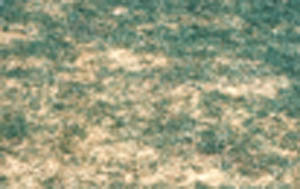What Is Killing My Turf Now? | |
|---|---|
| April 11, 2007 | |
|
I receive many questions about dead turf in March and April from homeowners wondering what disease has killed parts of their lawn. When we get a question about dead turf at this time of year, we usually look to something that has happened in the past. Sending a sample of dead turf to the lab probably won't provide a definite answer at this time of year, unless a snow mold fungus was present and has left telltale mycelial growth or overwintering structures. For the most part, dead areas do not yield the original pathogen. Saprophytic fungi have invaded the dead areas, and the original pathogen is unlikely to be revealed. Wait until symptoms appear again on actively growing turf, then sample the margin of the affected area-the area between dead and healthy grass. This is where the pathogen is most prevalent, if indeed a pathogen is involved in turf decline. At the U of I Plant Clinic, we usually ask for a 4-inch-by-4-inch sample of turf from the margin of the affected area. The sample should be deep enough to include roots. Wrap the soil and roots in plastic and put a rubber band around the sample at the soil level, leaving the blades out of the plastic. Follow submitting instructions on the Web site at http://plantclinic.cropsci.uiuc.edu/submit.html. Meanwhile, rake and remove the dead turf. Overseed with a blend of grass varieties adapted to your area. Visit this Extension site for information on lawn grasses: http://www.urbanext.uiuc.edu/lawnchallenge/ lesson1.html. Now is a good time to overseed, but be certain not to use a preemergence herbicide on the seeded area. Your weeds would not germinate, but neither would your desirable grasses. Sometimes it helps to look at the turf disease possibilities. Don't rely on images alone, because many noninfectious problems can look like diseases. The image shows turf damaged by a fertilizer application.  U of I Extension has a site on managing home-lawn diseases, http://www.urbanext.uiuc.edu/lawnchallenge/lesson8.html. Visit this site as a starting place to determining the possibilities. | |
| Author: | Nancy Pataky |
